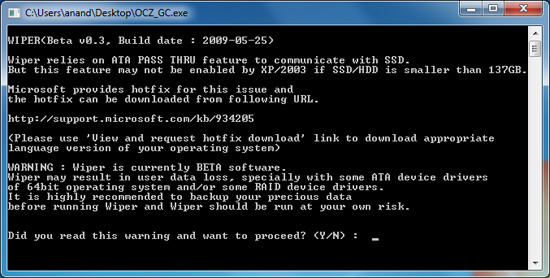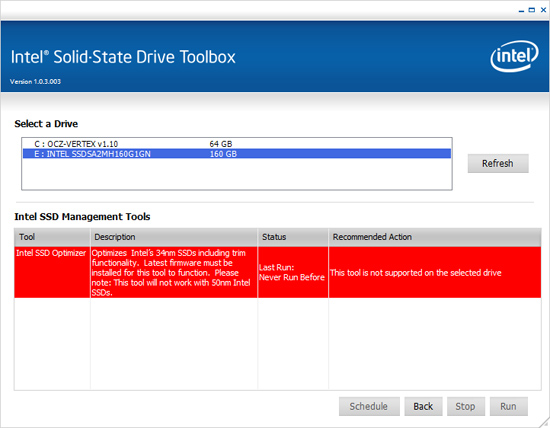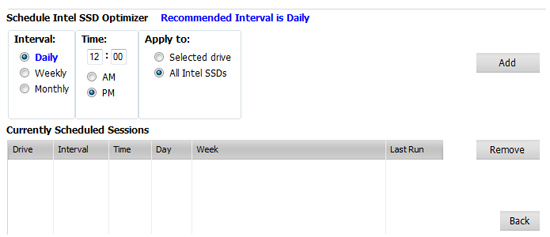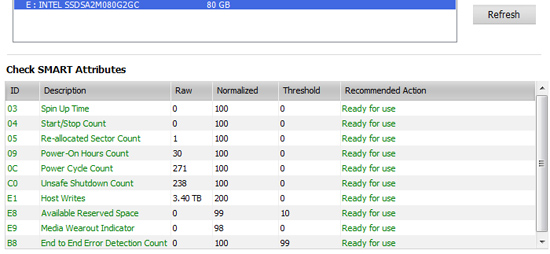The SSD Improv: Intel & Indilinx get TRIM, Kingston Brings Intel Down to $115
by Anand Lal Shimpi on November 17, 2009 7:00 PM EST- Posted in
- Storage
Wipe When You Can’t TRIM
There’s a major problem with TRIM today. The only Windows storage drivers to support it are written by Microsoft. The Intel Matrix Storage Manager (IMSM) driver will not pass the TRIM instruction to your SSD. This means you can't use anything but the drivers that ship with Windows 7. To make matters worse, if you enable non-member RAID on an Intel motherboard the default Windows 7 driver is an older version of IMSM so TRIM won't work there either - even if you don't have a RAID array created. Your best bet is to install Windows 7 with your I/O controller in AHCI mode (for Intel chipsets) and don't install any storage drivers. Intel is working on an updated IMSM that will pass the TRIM instruction to SSDs but it won't be ready for at least a couple of months.
TRIM won't work on a RAID array.
If you want to use IMSM or if you're using Windows XP or Vista, both of which do not support TRIM, there's another option. Earlier this year Indilinx released its Wiper Tool that performs a manual TRIM on their SSDs. It works by asking the OS for a list of the free space addresses on the partition and then sending the list with instructions to TRIM down to the SSD.

The Indilinx Wiper Tool
Today Intel introduces its own manual TRIM tool as a part of the SSD Toolbox:

On any Windows OS (XP, Vista or 7) regardless of what driver you have installed, Intel's SSD Toolbox will allow you to manually TRIM your drive. Intel calls it the SSD Optimizer, which of course only works on 34nm Intel SSDs (X25-M G1 owners are out of luck unfortunately).

The Intel SSD Optimizer lets you schedule the manual TRIM operation automatically
The SSD Toolbox also gives you access to SMART and drive health data, including telling you how many writes you've performed on your SSD, and what your current flash wear level is:

Running Intel's SSD Optimizer does work as advertised. I ran the PCMark HDD suite on a clean X25-M, once more on a drive that had been well used and once more after running the SSD Optimizer:
| PCMark Vantage HDD Score | Clean Run | Used Run | After SSD Optimizer |
| Intel X25-M G2 160GB | 35909 | 30354 | 34014 |
Intel's SSD Optimizer should be able to restore performance to about 95%+ of new, in this case it manages 94.7% - close enough.
Moving On: Forget About Invalid Data and Worry About Free Space
The existence of TRIM changes the way we test, something I alluded to in the SSD Relapse. Thankfully, we come prepared.
In previous articles we had to test SSDs in two conditions: new and used. The new state is just after a secure erase, the used state required us to write data to every user accessible portion of the drive first before benchmarking. The former resulted in great performance, the latter meant the SSD had to do a lot of juggling of existing data whenever it went to write. The second scenario no longer exists with TRIM. The act of formatting your drive or deleting files (and emptying the recycle bin) will TRIM invalid data.
Performance in a TRIM enabled system is now determined not by the number of invalid blocks on your SSD, but rather the amount of free space you have. I went into a deep explanation of the relationship between free space and the performance of some SSDs here.
TRIM will make sure that you don’t have to worry about your drive filling up with invalid data, but it doesn’t skirt the bigger issue: dynamic controllers see their performance improve with more free space.
My rule of thumb is to keep at least 20% free space on your drive, you can get by with less but performance tends to suffer. It doesn’t degrade by the same amount for all drives either. Some controllers are more opportunistic with free space (e.g. Intel), while others don’t seem to rely as much on free space for improved performance. Addressing performance degradation as drives fill up (with valid data) will be one of the next major advancements in SSD technology.










162 Comments
View All Comments
DanH - Monday, October 26, 2009 - link
Do what I did. Buy a Gen 2, clone your drive, and sell the Gen 1 on ebay while it's still worth as much as it is. You will easily get close to $200 for the 80 gig version. I lost $30 upgrading, which was very worth it for TRIM support and the newest hardware.masouth - Wednesday, November 18, 2009 - link
I must be misunderstanding you so please let me make sure I have this right...Someone bought your USED G1 for $30 less than you paid for your NEW G2!?!
A sucker born every minute.
mwaschkowski - Monday, October 26, 2009 - link
what cloning software did you use?I guess I couldn't switch to another SSD at the same time due to needing to clone the drive and using the same drivers between both SSDs?
DanH - Monday, October 26, 2009 - link
I used Carbon Copy Cloner on the mac, but Acronis TrueImage would work fine on PC.chizow - Monday, October 26, 2009 - link
Acronis True Image is probably the easiest for Windows, especially if you're cloning to identical sized drives. With the trial you can do this for free, I believe Seagate and WD have simplified free versions if you have one of their drives installed.Don't mess with any of the backup/restore options, go to the Utilities and choose Clone drive, then select destination and source drives. Takes about 10-20 minutes depending how much data you have and is effortless.
mwaschkowski - Tuesday, October 27, 2009 - link
OK, Thanks!!pcfxer - Tuesday, October 27, 2009 - link
sudo dd if=/dev/da0 of=/dev/da1Boot up into Knoppix and it is legitimately free.
Concillian - Wednesday, October 28, 2009 - link
No kidding. I clone my drive every once in a while on my fileserver with dd. Why it's made so difficult in every other OS is beyond me. I really shouldn't need to buy software in order to make a copy. It's a pretty basic function, really.Griswold - Thursday, November 19, 2009 - link
Just that the aforementioned software isnt primarily a cloning software but a backup and image software. Cloning a disk is just a minor function of it. And no, cloning a disk isnt a worthwhile backup strategy for most people.That said, I backup my system and data on a daily basis, but I only clone a drive once maybe twice a year. I wouldnt mind if it was built into windows, but its far from a necessity.
Taft12 - Monday, October 26, 2009 - link
This is nothing new, it has been well known for many years that there is a price to pay by being an early adopter.